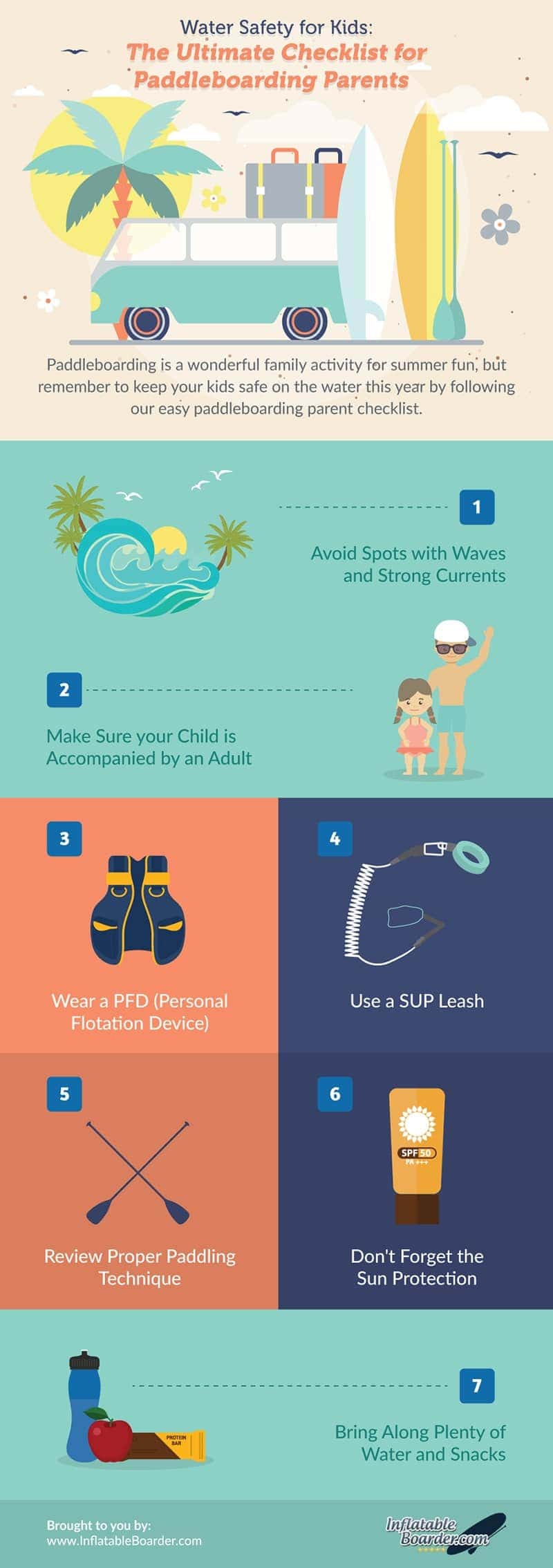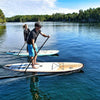When it comes to SUP'ing with your kids, aside from making sure they have fun, you want to make sure they stay safe!
We are happy to share this great guide for paddle boarding parents from our good friends at Inflatable Boarder.

#1: Avoid Spots with Waves, Wind, and Strong Currents
When preparing to paddle out with your children, it’s important to avoid areas with rough water, waves, wind, and strong currents. Calm lakes and bays are the safest places to paddle board with your kids, and they’re also more enjoyable.
It’s also a good idea to look for spots that offer plenty of places to get in and out of the water, and you need to make sure that there isn’t a lot of motorized boat and personal watercraft traffic.
#2: Make Sure Your Child is Accompanied by an Adult
If your child is old enough to paddleboard their own SUP, it’s important to make sure that they are always accompanied by an adult. Unfortunately accidents do happen, and having an experienced adult present at all times will help to ensure your child’s safety while paddleboarding.
Wearing a SUP PFD is a must anytime you and your child are out on the water. While adults have the option of wearing a belt-style PFD, children under the age of 13 must wear a USCG-approved life jacket.
#3: Wear a PFD (Personal Flotation Device)
#4: Use a SUP Leash
A paddle board leash is another must-have SUP accessory. SUP leashes ensure that paddlers won’t get separated from their paddle boards if they happen to fall off. Strong winds and currents can quickly move a board out of reach, so a SUP leash is an important safety accessory that can literally save lives.
#5: Review Proper Paddling Technique
If you’re going to bring your child along on your SUP, it’s important that they know where and how to sit. Since your SUP will be more unstable in the water with two people on board, it’s best if your child sits in a stationary position toward the front of the paddleboard.
Older children who are able to paddle board on their own board should be taught proper paddleboarding technique.
#6: Don’t Forget the Sun Protection
Overexposure to the sun is dangerous for kids and adults alike, so it’s always important to exercise caution while paddleboarding. Sunscreen and proper attire (sun hats, swim shirts with SPF protection, etc.) can greatly reduce the risks associated with sun exposure.
#7: Bring Along Plenty of Water and Snacks
Paddle boarding is great exercise and a super fun way to experience the outdoors, but it’s important to give your body the fuel it needs. Staying hydrated and bringing along some healthy snacks will ensure that you and your kids are up to the challenge!
 Glenn Morton is Customer Experience Manager at Cruiser SUP, as well as chief content creator. Glenn has been stand up paddle boarding and windsurfing over 20 years, and has been with Cruiser SUP for over 15 years. When not on the water, Glenn can be found on his road bike, a ski hill, or raising his 12 year old daughter Nora. Glenn is an expert in all things paddle boarding including paddle board technique, SUP safety, and all paddle board products. Customers rely on Glenn's expertise to help guide them in their purchase of the best stand up paddle boards for their needs. Glenn helps equip thousands of paddle boarders each year, and is ready and waiting to help you.
Glenn Morton is Customer Experience Manager at Cruiser SUP, as well as chief content creator. Glenn has been stand up paddle boarding and windsurfing over 20 years, and has been with Cruiser SUP for over 15 years. When not on the water, Glenn can be found on his road bike, a ski hill, or raising his 12 year old daughter Nora. Glenn is an expert in all things paddle boarding including paddle board technique, SUP safety, and all paddle board products. Customers rely on Glenn's expertise to help guide them in their purchase of the best stand up paddle boards for their needs. Glenn helps equip thousands of paddle boarders each year, and is ready and waiting to help you.

